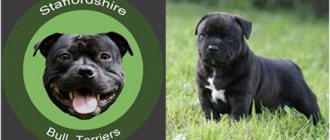A beautiful long-haired dog runs along the alley of the park. "Lassie, Lassie!" - the children shout while playing with her. But this collie does not look at all like the heroine of the film - she has silver-gray fur with small black spots and red tan marks. Picture two - American prairies, a herd of semi-wild cattle. An animal with shiny blue eyes curls around, irregular black spots are noticeable on its steel gray fur coat - the fur is a little reminiscent of... a hyena (blue merle color). This is a working Australian Shepherd. Because of its unusual eye color, the Indians called it a ghost dog.
Australian Shepherd Blue Merle
The nature of the unusual color
The source of the appearance of such dogs is a strong, expansive merle gene, called epistatic (also responsible for the occurrence of albinism). It modifies or disables another gene responsible for colors.
This gene, as a diluent, dominates in relation to the original shade, causing random lightening of the main color, for example, black. Information about the color of melanocytes, or cells with pigment, is stored on the chromosomes in a region called a locus. The M locus has 2 forms: with partially reduced pigmentation, that is, with lightening of the color - “M” and without affecting the pigment - “m”.
The most common are blue or blue “marbles” (blue merle) - the main color is black, lightening to gray. Border Collies or Australian Shepherds are brown merles. The base color alternates with cream, brown or light brown. Marble areas are not always made up of only two colors (gray and black or cream and brown). Sometimes additional genes cause intermediate shades to appear. This is undesirable in blue merle, but looks attractive in chocolate.
How is merle made?
The dominant M gene, which causes albinism, is responsible for the appearance of merle. If it is present, the dog will always be spotted. The M gene blocks pigmentation, turning a solid color into a “diluted” one.
When breeding, marbled quadrupeds are crossed with tricolored ones. The latter do not have the M gene in their DNA. Their color is uniform, but consists of 3 colors: the main one and 2 additional ones. Mating these animals with each other is not dangerous. One half of the puppies obtained from them acquire spotted fur, and the second - tricolor.
Deviations are observed when two marbled parents are mated. In this case, 25% of their offspring inherit 2 dominant M genes at once, another 25% are born tricolored, and the remaining 50% are spotted, but with only one M gene.
What is double merle
When two individuals with the merle pattern are bred, each puppy in the litter has a 25% chance of inheriting the gene from both parents. The resulting offspring is called double or homozygous merle. In breeds that have white markings on the head, neck, paws, belly, and tip of the tail (Irish, Collie, Border Collie, Scottish, Australian Shepherds), double marbling is easy to recognize at first glance. They usually only have a few spots. Even the standard marbles of these rocks have a slightly greater white accent than their unmarked siblings (though this is not the rule).
Welsh Corgi Double Merle
Additional information . Ordinary merles are healthy dogs, but “doubles” may have varying degrees of impaired vision and hearing. This is because at double the dose the merle gene causes too much pigment restriction. The structures responsible for hearing and vision are also formed from the same cells as pigment cells.
Vaccinations and susceptibility to disease
The Spotted Pitbull is prone to a variety of illnesses, so it's worth visiting your veterinarian every three months.
Frequent problems faced by pit owners:
- deafness;
- blindness;
- sterility;
- heart diseases;
- diseases of the digestive system.
The vaccination schedule for puppies includes the first vaccination at the age of 8-9 weeks and a booster vaccination at 12 weeks (enteritis, distemper, leptospirosis, parvovirus, hepatitis).
At 7 months a rabies vaccination is given. In the future, to maintain immunity, dogs are revaccinated annually.
It is important to understand that during this period the puppy’s body is weakened, so the risk of natural infection increases. For vaccines that require repeated administration, a two-week quarantine is required after the second vaccination, since the animal is more susceptible to viruses and diseases
The mystery of the origin of merle color
Despite the fact that dogs share 95% of their genes with wolves, they are very different in both behavior and appearance. The domestication process took place about 15-25 thousand years ago. During this time, many breeds with different coat colors were developed, but the merle color in dogs looks very original. The mystery of why marbled puppies constantly appear in the litter, even if such individuals were not used for mating, has not been fully solved.
The coat color is called "merle" in English, which means "marble" because it resembles the rock of the same name. A similar color has long been known among shepherd dogs. Each marbled dog has a unique patch. This diversity also applies to the eyes. They can be:
- blue;
- one is blue, the other is brown;
- half blue;
- speckled;
- brown.
It all depends on where the patch lands. It looks like they threw paint on an animal. Although the distribution of spots is usually irregular, there are dogs with a symmetrical arrangement of some of them. It looks intriguing when half is black or chocolate and half is marble.
*Ticking and merle are not the same thing! They are so often confused.
What is mottling (ticking)?
Tick refers to small spots (specks) on the white areas of a dog's coat. Imagine a dog covered with a white cloth with holes cut into it. The speck is the base color that can be seen through the holes in the fabric. The basic color of the dogs (without white), may have specks. However, we will not be able to see it as it is only visible in areas with white fur.
Marking is characteristic of many dog breeds, but it is best known from the example of Dalmatians and English setters. Also, many spaniels can have a speckled color.
In the photo there is a teak (speckled) dog - Jasmine Pete Right
List of genetic problems associated with the M gene
Breeds that have the mutation:
- dachshund;
- Great Dane;
- pug;
- French Bulldog;
- coolie;
- Australian Shepherd;
- long-haired and short-haired Scottish Shepherd;
- corgi cardigan;
- Border Collie;
- leopard dog.
Leopard Hound
When a breeder is not sure whether his pet is a merle, it is recommended to have a test done. Homozygous individuals (MM) are sometimes born:
- with deformity or complete absence of eyes or ears;
- partially or completely deaf (54.6% of MM-homozygotes and 36.8% of MM-heterozygotes were found with hearing problems of varying severity - from mild to complete deafness);
- barren;
- predisposed to eyeball abnormalities (flattened fundus, twilight blindness, risk of developing cataracts).
Important! Deafness has not been found in the Catahoula leopard dog, even in the homozygous system (MM).
Dominant homozygotes arise only from the combination of two individuals - carriers of the M gene. In many European countries, their mating has been banned.
Is it worth the risk?
Pit bull terriers are dogs with a special character. They need education, otherwise problems will arise in communicating with people. While a standard breed can be trained, the behavior of artificially bred dogs cannot be predicted. The result of selection may be unpredictable, both in terms of the dog’s health and behavior.
According to the standard, the M gene is found in some varieties of shepherd dogs, dachshunds and collies
The M gene very often affects the animal's ability to reproduce further. An albino pit bull is one of the options for how the introduced gene can behave. The birth of a white dog is considered one of the most harmless deviations.
Note! Pigment cells are formed along with cells of the nervous system, so deviations in their development can provoke mental illness.
Since pit bulls are quite large dogs, their uncontrollable nature can become a real danger to the environment. Considering the above risks, you need to think twice before buying or breeding an unusual breed.
Why is it dangerous to breed such dogs on purpose?
The merle coloration is interesting and unique, which is why the puppies attract a lot of interest from buyers. However, breeders should be aware of the risks associated with inappropriate selection of breeding pairs.
Since the merle gene does not affect red coloration, mating of merle and dark (red) pairs of collies and Scots is avoided - puppies of an undesirable color may be born. Most animals have a black coating on a red background, and only on this are marbled spots visible. Then the red color may seem dirty.
On a note! Among Border Collies and Mudi you can find dogs with pure red, cream or biscuit colors (Golden, Labrador). In their case, the merle color may not appear in the coat, but only in the eye color. Meanwhile, blue eyes in a white or fawn Mudi are a defect - a reason for disqualification.
The dark side of the gene
Sometimes the merle color in dogs is not noticeable, you may not notice the crossing with another merle, but this should not happen, because the merle gene has its own dark side. If you cross a merle with an unmarked individual, statistically half of the puppies will be merle and half will not. Or half the children will be regular merle, a quarter will be standard merle, and a quarter will be double merle. Thus, crossing merles does not increase the chances of producing regular merles, but rather increases the likelihood of producing deaf or blind puppies.
Additional Information . Marbled pit bulls, cocker spaniels, and chihuahuas appeared in America. In these breeds, this coloration is the result of experimental matings (in the case of the Chihuahua, probably with a Sheltie). The Merle Spitz is also bred using a gene mutation. The reason for this practice, unfortunately, is the financial motivation of breeders.
Is it possible that merle was in the breed before, but is only now showing up?
The genetic and phenotypic nature of the merle and merle allele (M) is such that it would not go unnoticed in the breed and appear suddenly. This could only appear when mated to another breed that carries the merle allele. That is, only in this way could this color be introduced into the breed. The reason this could not remain invisible or hidden is because merle is a dominant color. This means that if it is present within the genome in general, even in a heterozygous (one copy of the gene) state, it is expressed and obvious. Accordingly, this could not have been hidden or “frozen” in the rock for many years and not manifest itself in any way until the beginning of the 20th century. M alleles are not found in most breeds, which effectively means that most breeds are not carriers of this color. Finally, this gene certainly cannot arise spontaneously or through mutation, as some have suggested.
The nuances of owning and training a marbled Chihuahua
The Chihuahua is a very small breed. However, the character of the breed’s representatives is not entirely in harmony with the small body dimensions. These are brave and smart dogs that are not afraid of challenges and often face much larger dogs.
Dogs of this breed are usually quite distrustful of strangers, patrolling their territory and loudly warning in case of an intruder. These little ones are very smart, but if you neglect their upbringing, they turn into very barking and disobedient pets. In addition, the merle color of a Chihuahua arouses interest among passers-by, which can frighten the baby. If your friend's anxiety is excessive, it may be best to take a course with a trainer to restore confidence.
Marbled Chihuahua is prohibited
It is better to teach using encouraging methods, using rewards and gratitude. If your pet doesn't do something, you shouldn't use harsh punishments. During the day, 3-5 workouts of 10-15 minutes are introduced. For correctly executed commands, they are given a reward in the form of their favorite food or treat.
Photo
Take a look at the photos of adult pit bull terriers and puppies with this color:
Here are other spotted breeds:
Corgi
Chi hua hua merle
French bulldog
Australian Shepherd
Australian Shepherd puppy
Shorthaired collie
Husky
The effect of the merle gene on the health of Chihuahuas
Representatives of Merle Chihuahuas have recently appeared in some American nurseries. This coloration has never been part of the species' history. According to geneticists, Chihuahuas were given the merle color of a dachshund or sheltie.
In addition to the fact that the breed is susceptible to joint diseases, marbled species, in addition to exotic coloring, also have their own pathologies (even with a single Mm):
- lens dislocation and corneal dystrophy;
- high mortality of newborn puppies;
- high probability of giving birth to crippled puppies (without an eye or ear);
- birth of infertile animals;
- gross anomalies of the sensory organs;
- sperm deficiency.
You should provide your pet with a calm walk without straining the joints, and beware of overheating and cooling. In hot weather, allow yourself to drink more water.
The opinion of dog handlers
The opinions of dog handlers regarding these dogs are divided into two camps. Some consider the idea to be successful and have a positive attitude towards the development of a new breed. In their opinion, it only takes time to improve the dogs and eliminate the possibility of deviations and defects.
Others believe that the idea of breeding an Albanian pit bull is doomed and will not be successful. A gene mutation can harm aggressive dogs and make their temper even worse. Experts say that such dogs cannot be kept at home, but only in kennels.
The effect of the merle gene on the pit bull
The Staffordshire Bull Terrier and the American Pit Bull Terrier are descended from a common ancestor, the Bulldog. They are bred specifically for fighting. Where did this color come from, what health problems can the merle gene cause, is this a defect in the breed? In the community of American pit bull lovers, they believe that their merle color appeared after crossing with leopard dogs. If an animal has genetic color defects, there may also be abnormalities in the functioning of the nervous system (mental and neurological abnormalities).
In addition to the color white, albinism in animals also affects the color of the iris - hence blue eyes. There are colors that are prohibited for breeding, but popular among dog lovers, for example, a white pit bull with blue eyes.
The Isabella (champagne, lilac) pit bull has shades from blue to light chocolate and fawn with a silver tint. Different lighting makes it possible to admire the nuances.
Marbled pitbull
The genes responsible for the color of a dog's coat are not fully understood (the phenotype is tested rather than the genotype). Therefore, some of the information is only hypotheses, theories designed to explain phenomena observed in culture. Merle-colored animals have long functioned as working dogs, often under difficult conditions—and they do very well.
Vaccinations and susceptibility to disease
Vaccinations are given to pit bull terriers at puppyhood according to the schedule, and then once a year. The list of vaccinated diseases is no different from other dogs:
- carnivore rabies;
- parvovirus enteritis;
- carnivore plague;
- adenovirus;
- leptospirosis;
- viral hepatitis;
- parainfluenza
Diseases that pit bull terriers are prone to:
- dental diseases;
- infectious diseases;
- obesity;
- hip dysplasia (genetically transmitted);
- various scabies (otodectosis, sarcoptic mange, flea dermatitis, notoedrosis, demodicosis). Although notoedrosis is feline mange, dogs can also become infected, as can cats with sarcoptic mange. Moreover, the mites that cause these diseases in dogs and cats can also bite people, but humans will not have specific symptoms of scabies;
- allergies;
- disorders of the thyroid gland;
- diseases of the cardiovascular system (aortic stenosis).
It is unlikely that you will be able to treat diseases on your own. It is much safer and more effective to contact a veterinarian. The only exception is an allergic reaction. When your pit bull has an allergy, you need to give an antihistamine as quickly as possible.
Basic rules of care
It is recommended to brush Albanian pit bulls with a brush for short-haired dogs or a special mitten once a week. They are bathed no more often than once every 2 months, and it is recommended to use hypoallergenic shampoos for short-haired dogs.
Ears and eyes should be examined regularly, but cleaned only when they become dirty and, preferably, using special cleaning products..
You can brush your pet's teeth 1-2 times a week with a toothbrush and dog toothpaste, or simply give him chewing toys or treats designed to remove plaque.
Nails are trimmed with nail clippers if they grow excessively and begin to curl inward, causing discomfort to the dog.
Albanian Pibuls are not intended for year-round outdoor keeping because due to their short hair and complete absence of undercoat, they do not tolerate frost well..
Character traits
Albanian pit bulls differ from standard dogs only in their unusual coloring, but not in their temperament. They are just as confident, energetic and active.
These are very hardy, strong and practically insensitive to pain animals, characterized by well-developed hunting instincts and innate aggression towards other people's dogs..
Like standard pit bull terriers, representatives of the Albanian variety of this breed are always ready for action, they are not afraid of anyone and are ready to fight with any opponent, even if they are several times their size.
CAREFULLY!
Aggression towards people in these dogs should be unacceptable in principle; moreover, all attempts to develop it in an Albanian pit bull can lead to very sad consequences, up to and including complete uncontrollability of the pet’s behavior.
Due to characteristics associated with the merle color gene, Albanian pit bulls can be mentally unstable and more aggressive than dogs of other, standard colors.
Basic colors
- Blue merle (blue merle) . Black spots of uneven shape, scattered on a light grayish background, complemented by white markings.
- Red merle (red merle) . Spots of a brownish or reddish hue, located on a pale brown, beige or fawn background. This color also has white markings that set off the main color of the coat.
Many Albanian pit bulls have more or less pronounced tan, and the brighter it is, the more impressive the dog looks.










